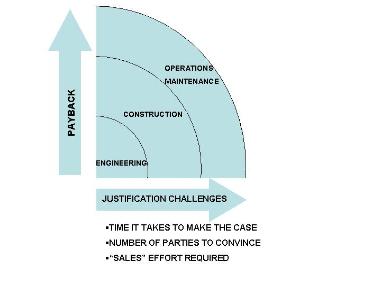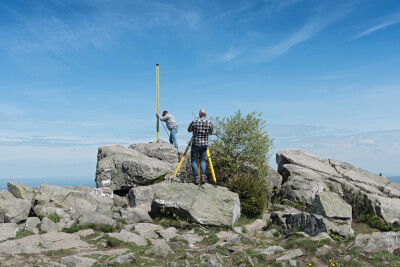The magnitude of potential benefit from laser scanning increases significantly as we move from comparison with manual methods to project execution considerations to operations and maintenance
benefits – so does the complexity and difficulty of making a convincing economic justification.Spar Point has developed a framework for the cost/benefit analysis of using laser scanning methods to capture existing conditions information. Our framework starts with a comparison between laser scanning-based methods and manual methods. Next it analyzes the impact of laser scanning on project execution risk, and finally the potential impact on operations and maintenance of capital assets.
At the most basic level, direct cost comparisons with manual methods may be straightforward to carry out, but may not reveal the most significant returns available. At the other extreme, the impact on operations and maintenance, while potentially great, may be too difficult to pin down, at least for now. Of course, if the case for laser scanning can be made because it is less expensive than manual methods, all the downstream benefits become found money.
Certainly the payback threshold varies with a given company’s industry, attitude toward new technology, investment in 3D design tools and other factors. Some may conclude that laser scanning is not justifiable for them, at least at the present state of the art.Direct costs of laser scanning versus manual methods
We do not subscribe to the view that laser scanning is cost-justified for every project. In deciding whether to automate any process, sound engineering practice is to have a rich understanding of the advantages, costs and risks of the best manual alternative.
We know of some instances where practitioners justified the cost of laser scanning simply because it is less expensive than the manual methods it replaces. Travel time and direct travel expense to get to and from the job site to conduct manual surveys mount quickly, when large crews are required and when the location of the job site means significant ground and even air transportation cost.
However, trying to compare the cost of laser scanning with traditional methods it replaces is not always straightforward. Often there is a paucity of data about the costs of capturing existing conditions using
traditional manual methods, many of which are hidden or dispersed throughout the project budget.
Further complicating the cost comparison is that laser scanning is not always a direct substitution for the tools and techniques it replaces. In some ways, comparing laser scanning with traditional methods is like comparing an automobile with a horse. The direct costs may in fact be greater, but the benefits could more than compensate.
Laser scanning may still be compelling even if competing manual methods are nearly free. But whether this is the case depends strongly on the expected use of the information. For example, on jobs where the geometry is simple, the work site is readily accessible and the construction allows for field engineering, laser scanning may be a poor choice.Impact on project execution
Laser scanning’s potential to reduce project execution risk starts with more accurate, higher-confidence bids. Correct and complete existing-conditions data is a prerequisite for accurate bidding. Yet bids are too often based on inaccurate or incomplete information about existing conditions. Laser scanning is starting to be used to remedy this, due to its speed and completeness. Owner resistance to deploying scanning at the bid phase in capital projects seems to stem from a reliance on traditional work processes, an inertial “we leave that to our contractors” attitude founded in a desire to outsource the exposure to existing conditions.
Beyond the bid phase, faster, better, cheaper, lower-risk project execution through reduced errors and rework is a central business driver for using laser scanning. In greenfield projects, field rework in excess of 1% of the project budget is generally considered unacceptable. However, in brownfield situations, rework today can be in the range of 5% to 10%.
With laser scanning, some practitioners report it is possible to drive rework in brownfield jobs down to the sub-1% levels of greenfield projects. Indeed, while estimates vary by industry, experience is leading
many to conclude that from 2% to 5% reductions in the total installed cost of a brownfield or revamp capital project can be achieved through better capture and use of existing-conditions information.
Even conservative estimates mean a big boost to the bottom line for contractors. In cases where field rework is 5% to 10% of a project’s total cost, and better existing-conditions data reduces rework 10%, this means laser scanning can save between 0.5% and 1% of total project cost. Contractors with project margins in the low single digits view this added margin as a boon.
For owners, the business impact is faster time to market, fewer days of lost capacity or other asset use value, and help with the hard-to-quantify but vital issues that affect a company’s relationship with the public such as safety and environmental concerns.Improved responsiveness to change
Of course field rework is driven not only by errors, but also by project scope changes due to exogenous factors such as a shift in demand or other market conditions for the owner. Terrestrial laser scanning can help contractors be more responsive to changes encountered in mid-project. For example, by providing rapid documentation of construction and field conditions to date, laser scanning can help contractors carry out options analysis and explore the impact of changes on schedule and cost.
Another example is where a contractor’s purchasing department decides to switch suppliers for a given piece of equipment. While functionally equivalent, the new product may have somewhat different geometry than what was originally specified. Laser scanning can help designers respond to such changes with greater agility and flexibility.
Schedule reduction
By reducing errors and rework, and improving responsiveness to project changes, laser scanning benefits not only direct project costs but also schedule. Avoiding the costs of schedule overruns – lost capacity in process and power plants, added days of traffic lane closures in transportation projects, lost production on offshore platforms, lateness to market and lost opportunity in consumer products – can have even greater economic impact than reducing direct project costs.
Survey of existing conditions for detailed design purposes is often a critical-path item. We believe this may explain many project managers’ reluctance to take chances on new methods such as laser scanning, at least on large projects.
A challenge for the laser scanning industry is to break through the crust of resistance with this group, project manager by project manager. This is especially tough because laser scanning comes early in a project, before delays and cost overruns have softened the project manager’s resistance to trying new techniques, which leads to a perennial “maybe next time” effect. Safety
Laser scanning often permits existing conditions to be captured more safely than traditional methods. Indeed, the economic case for adopting laser scanning methods becomes quite clear in light of the cost of poor safety practices. One DOT representative informed us that just the cost of litigation in cases of accidental loss of life of highway survey personnel was sufficient motivation to consider the use of laser scanning.
Laser scanning has also helped to reduce or eliminate the need for personnel to take physical risks in large-scale civil infrastructure projects. For example, in the Hoover Dam Bypass project, laser scanning was used to document canyon walls on which bridge footings were to be placed, reducing the need for workers to rappel down the canyon walls.
Safety is also a major concern in the nuclear industry. For example, when Washington Group International used laser scanning in a nuclear plant modification, it reported that workers’ radiation exposure was reduced an estimated tenfold compared with using manual measurement techniques. Similarly, in process plants, laser scanning can let field personnel take complete measurements without climbing dangerous heights or spending time in hazardous environments.
Fabrication quality control
Terrestrial laser scanning is also proving its value as a tool for quality control of fabrication. To reduce the cost and schedule impact of misfabricated pipe and equipment, contractors are scanning tie-in
locations on the job site, then scanning equipment and fabricated pipe before shipment to the site to ensure correct fit.
This technique has particular value in situations where rigging costs are high, for example where a crane or other expensive equipment will stand idle if fabricated product turns out not to fit. In addition, laser scanning can help lower fabrication costs by enabling contractors to reduce the number of field fit weld operations.Construction management, progress monitoring, construction sequencing
Used for field verification of construction work, laser scanning can monitor not only progress and schedule adherence but also construction accuracy – and thus help owners control payments to
contractors.
We believe laser scanning will also be used as a construction sequencing tool, due to its ability to support clash detection and avoidance. Will HVAC work scheduled for a particular time clash with
electrical work? For easier fit and access, which job should go first? In situations like these, laser scanning can aid planning and mid-course corrections on the job site.
Related to laser scanning’s utility for construction management is its potential to help in cases where the same design is going to be constructed multiple times. Practitioners are beginning to talk about
scanning the first completed facility, then updating the as-designed CAD model to conform to as-built conditions so that the next construction project can be executed more rapidly and with fewer errors.
Some also expect laser scanning to be useful in litigating construction claims. The approach envisioned is that laser scanning will provide complete, unambiguous documentation of site conditions before, during and after construction. By comparing these scans, claimants or defendants will be able to prove exactly what work was done to the site.Impact on operations and maintenance
Beyond laser scanning’s impact on capital project execution, its greatest economic potential may lie in helping maximize the asset’s value across its operational life. Documenting the as-built facility to improve operations and maintenance, probably on an ongoing basis, offers great promise.
Today, however, asset lifecycle considerations are much more difficult to use in cost-justifying laser scanning than its project impact. Use of the technology for operations and maintenance is largely unexplored territory, and the work processes are far from settled. Should all scanned data be converted to CAD models? How should the scanned data be made intelligent – should it be correlated with intelligent design data, tied to operations and maintenance databases, or some other way? How will practices differ from one industry to another – process, power, transportation, civil infrastructure, discrete manufacturing, commercial buildings?
Another obstacle is that today, up-front investments in laser scanning are most often funded from project cost centers that have little incentive to make investments that won’t pay back until the operational phase. Nevertheless, we expect that in time, laser scanning will become a valuable tool for operations and maintenance. How rapidly this comes about will depend on scanner price declines, more rugged and reliable hardware, advances in software for managing scan data and making it
intelligent, and further development of the work processes required.
This material is excerpted from Spar Point’s just-released publication
Capturing Existing Conditions with Terrestrial Laser Scanning: A Report on Opportunities, Challenges and Best Practices for Owners, Operators, Engineering/Construction Contractors and Surveyors of Built Assets and Civil Infrastructure






